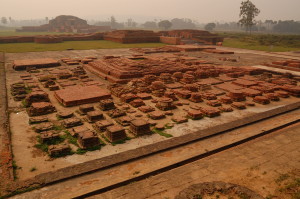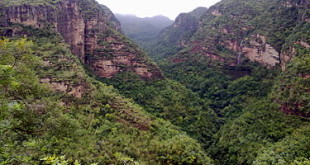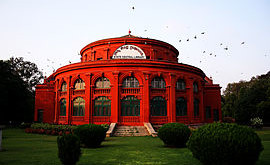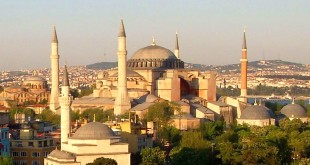I was travelling alone, soon after my graduation, from south to north part of India as I couldn’t even seem to fathom the idea of what I’d want to do in my life. Instead of starting my career in the corporate world at 20, spending the next 40 years of my life working 40 hour weeks and waiting for those 2 weeks of vacation to spend each year. I wanted to do something different by travelling and exploring the world for a while when I could.
Starting my journey from Bangalore I reached Bhagalpur. I recalled hearing praise of a village called Antichak, where Vikramashila University was situated, which was likened to the notable University of Nalanda in late 8th century. This provoked curiosity in me and I was eager to visit and explore the site. So I hired a car from Bhagalpur and started the journey.
The scenic roads stretched along the bank of the Ganges, where the village folk songs from the paddy fields on my right formed an orchestra with the sound of rustling wind and the flowing river on my left. The paddy fields were in various shades of green and the fertile Gangetic plain extended till the horizon. I went past Ghogha and reached Kahalgaon continuing the journey, it eventually became slow and tiring due to the conditions of the road.
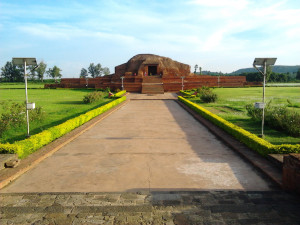
About 15kms journey from Kahalgaon following the directions of the local people, I finally arrived at the gate of Vikramashila complex. It was a huge place spread across more than 100 acres and the site was beautifully landscaped by ASI. The huge majestic structure of the monastery with its imposing Stupa came into my view at the backdrop of rolling hills, emitting peace.
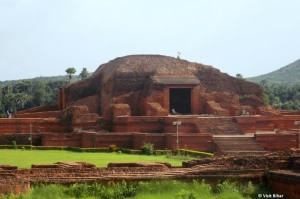
I hastened towards the ruined yet beautiful structure on the renovated path with well-maintained gardens on the either side. The breeze carried with it a calming sensation and each brick that formed the monastery, with the terracotta plaques that decorated the walls and the mortar, seemed to be chanting “Buddham Sharanam Gachchaami” thereby persuading the travellers to seek the refuge of Buddha for salvation. My hands as if somehow gained a mind of their own, touched the walls and I felt peace vibrating throughout my body.
There were ruins around the main monastery and stupa, which probably were used as classrooms and library and an elaborate gateway, where I was able to see a huge cluster of votive stupas erected by the devotees for gratitude or fulfilment of their desires.
Adding to the clever construction, confined, underground rooms were also discovered and are believed to have been used for meditation. It’s hard to digest the fact that even though being built in 8-9 CE, the library had an air conditioning system. The system worked with the help of the water reservoir on the side of the library.
Built for worship, the main stupa is a brick structure, in the centre of the square monastery, it is laid in the mud mortar. “This two-terraced stupa is cruciform on plan and about 15 metres high from the ground level accessible through a flight of steps on the north side. On each of the four cardinal directions, there is a protruding chamber with a pillared antechamber and a separate pillared mandapa in front. In the four chambers of the stupa were placed colossal stucco images of seated Buddha of which three were found in situ, but the remaining one on the north side was possibly replaced by a stone image after the clay image was somehow damaged,” the leaflet read as I walked through the corridors towards the ends of one of the antechambers.
According to our local guide, this was one of those residential universities with elementary school education which was one of its kind, where students were sent to the teacher’s house and they stayed with their instructor until they were 20 or 24 years old (just like Gurukul in Vedic periods).There were a large number of antiquities made of different materials, unearthed from this place in the course of excavation, as displayed in the site museum.
The ruined University, no longer serving the purpose, was constructed by King Dharmapala of the Pala dynasty (783 to 820) in response to a decline in the quality of scholarship at Nalanda. It was one of the largest Buddhist Universities, with more than one hundred teachers and about one thousand students that produced the most distinguished and eminent scholars who were often invited by foreign countries to spread Buddhist learning, culture and religion. It functioned for about four centuries before it was destroyed by Bakhtiyar Khilji, a Turkish military general of Qutb-ad-Din-Aibak, in 1200.
As I looked around at the structures and the ruins in the place, there was an inescapable peace over all of them. The most harrowing part of this was that these peaceful structures, such as the complacent and peaceful Buddha statues at the end of the cruciform shaped stupa, had stood witness to one of the most painful cleansings that the world had seen. In the name of religion and hatred, these peaceful structures stood in complete inaction as Bhaktiyar Khilji and his men ravaged the place and burned centuries worth of knowledge which may have had the power to change our lives forever. Now, these very statues, stupas and walls, which stood the flames of destruction and the birth of knowledge throughout history, stood unwavering, peaceful as ever as I looked at them with a heavy heart.
Bijay Kant Dubey in his poem “Bakhtiyarer Ghora(Horses of Bakhtiyar)” asks:
“Bakhtiyar Khilji, how notorious and conservative
Had you been that you destroyed
The seats of learning,
Finished them all,
Nalanda, Vikramashila, Odantapuri and so on,
Were you a criminal,
A criminal, Bakhtiyar,
Did you not get education
In Turkey
To be Turkic horde
To finish it all
What good it was in education?”
The university still stands today with its ruins in all its glory, boasting of its unique and rich history. Every year the place hosts the Vikramshila Mahotsav, a festival, during the month of February. But, it still stands as a reminder of an unwavering history, one wrought with the agonizing truth of destruction and the beautiful surge of knowledge and information, a pattern which we must get used to even if we are ignorant of the same. My trip back filled me with a sort of humility as well as a sense of wonder for things to come; maybe the place had told me something that I was yet to realize.
 The Holy Connection An Alternative Exploration of Existence
The Holy Connection An Alternative Exploration of Existence

